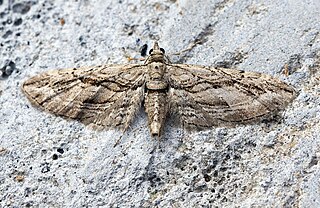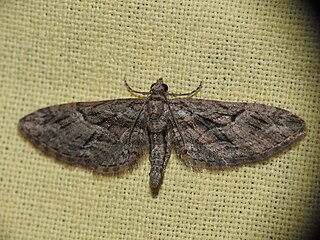
The juniper pug or juniper looper is a moth of the family Geometridae. The species was first described by Michael Denis and Ignaz Schiffermüller in 1775. It is found throughout the Palearctic and in the Nearctic.

Eupithecia phoeniceata, the cypress pug, is a moth of the family Geometridae. The species was first described by Jules Pierre Rambur in 1834 and it can be found in Europe.

Eupithecia satyrata, the satyr pug, is a species of moth of the family Geometridae. It was described by Jacob Hübner in 1813. It is found from Ireland, through northern and central Europe east to all of Russia and central Asia and western Siberia to Tibet. It is also present in North Africa and North America.

Eupithecia denotata is a moth in the family Geometridae. The species can be found across the Palearctic from western Europe to Central Asia and China.
Eupithecia andrasi is a moth in the family Geometridae. It is found in north-western China in the Shaanxi province. The holotype was collected in 1936 in the Daba Mountains at about 3,000 m (9,800 ft) above sea level.
Eupithecia levata is a moth in the family Geometridae. It is known from Lijiang in Yunnan, south-western China.
Eupithecia omissa is a moth in the family Geometridae. It is found in north-western China in Shaanxi and Gansu provinces.
Eupithecia fenita is a moth in the family Geometridae. It is known from northern Yunnan in south-western China.
Eupithecia molybdaena is a moth in the family Geometridae. It is known from the Daba Mountains in Shaanxi, western China.
Eupithecia lamata is a moth in the family Geometridae. It is known from Qinghai, western China.
Eupithecia tepida is a moth in the family Geometridae. It is known from the Daba Mountains in Shaanxi, north-western China.

Eupithecia ericeata is a moth in the family Geometridae first described by Jules Pierre Rambur in 1833. It is found in most of southern Europe and the Near East.

Eupithecia oxycedrata is a species of moth in the family Geometridae. It is found in Spain, southern Portugal, the Balearic Islands, southern France, Corsica, Sardinia, Sicily, Malta, Italy, Slovenia, Croatia, Bosnia and Herzegovina, Montenegro, North Macedonia, Bulgaria, Greece, Crete, western Romania and the Crimea. It is also found in North Africa, from Morocco to Tunisia, and in Turkey. The habitat consists of dry maquis, especially where junipers grow.

Eupithecia poecilata is a moth in the family Geometridae. It is found on Corsica and Sardinia.
Eupithecia pieria is a moth in the family Geometridae. It was first described by Herbert Druce in 1893. It is found in Mexico and Bolivia.






